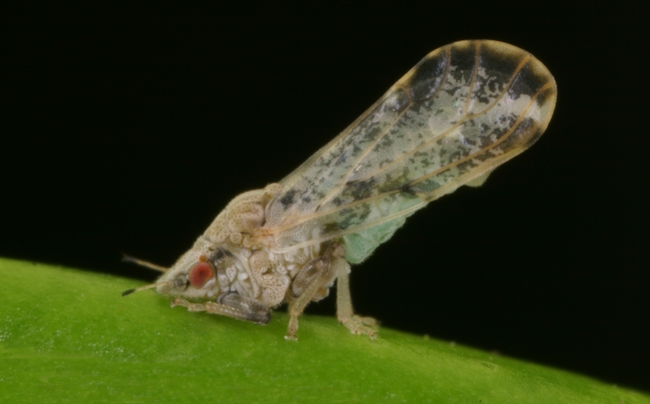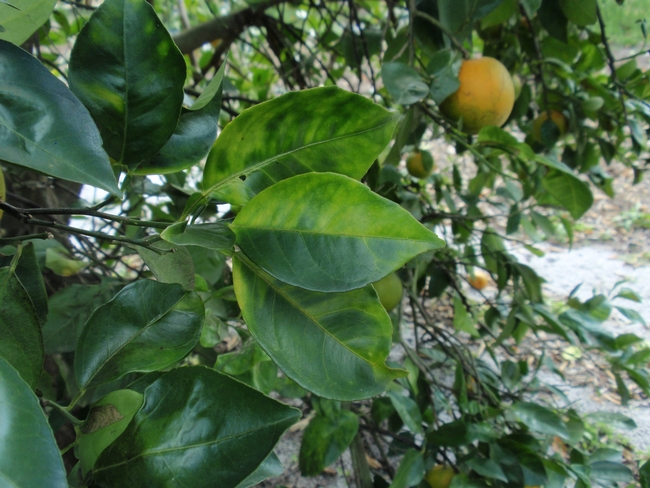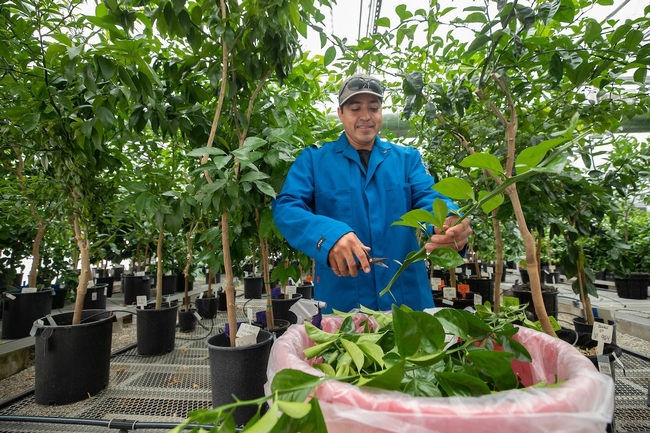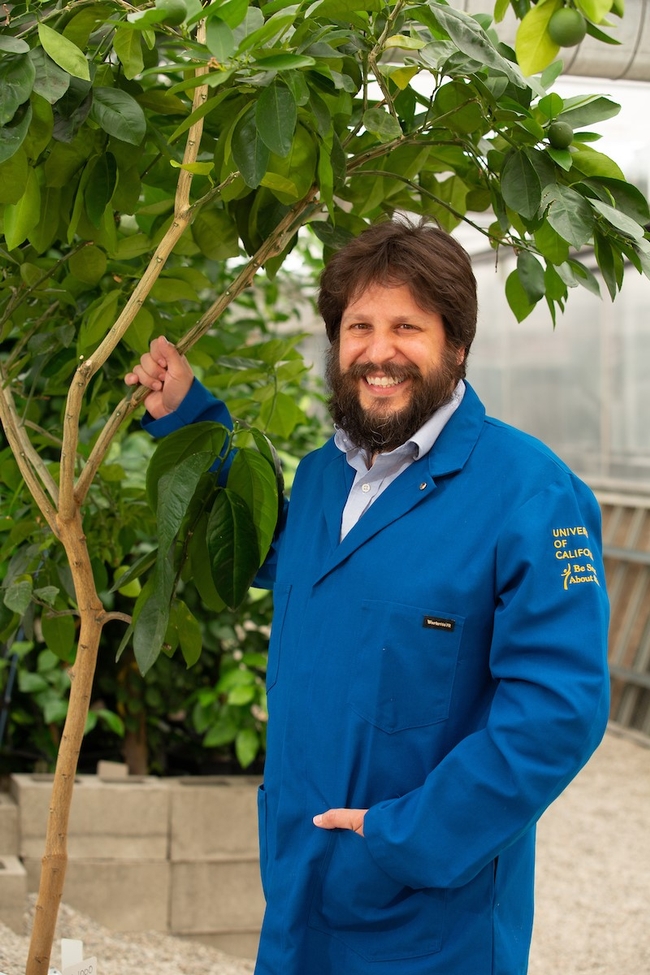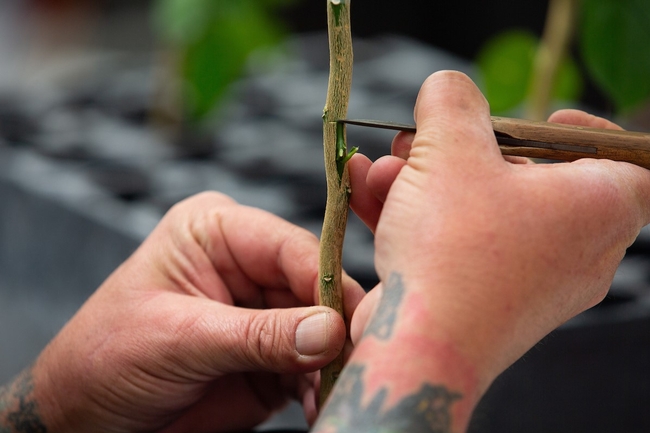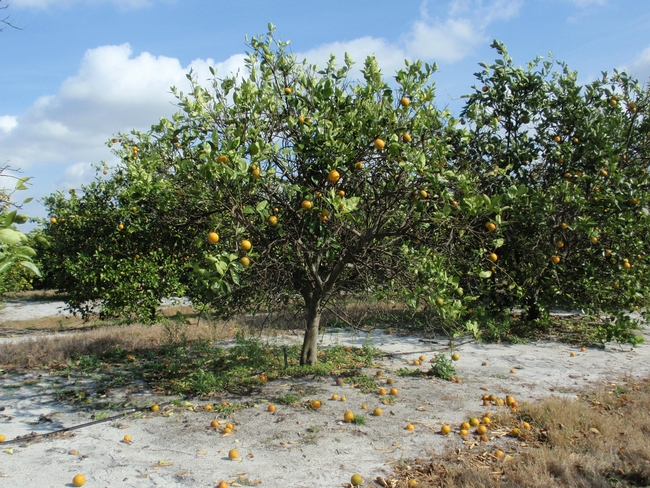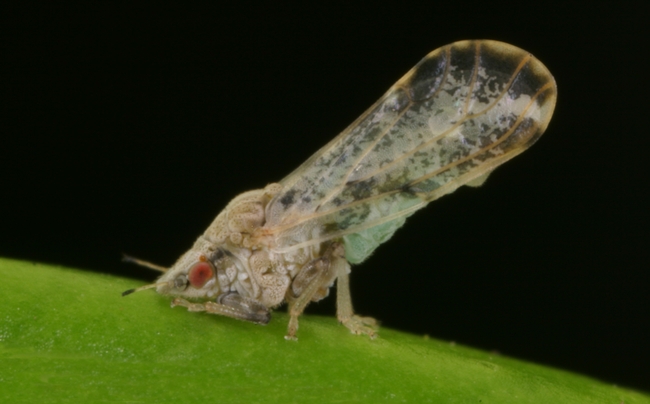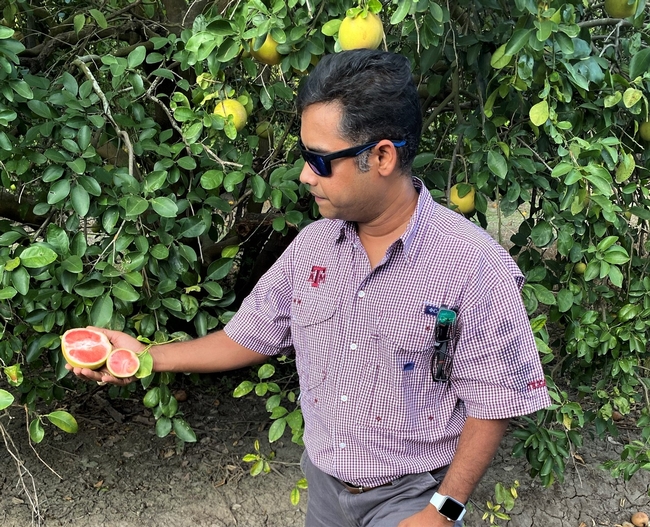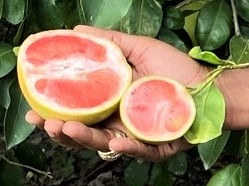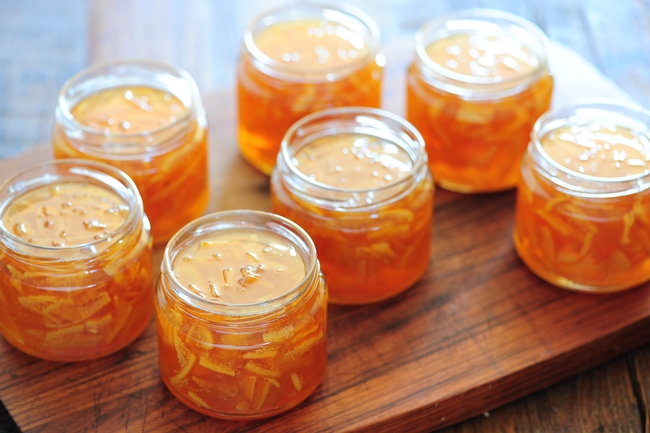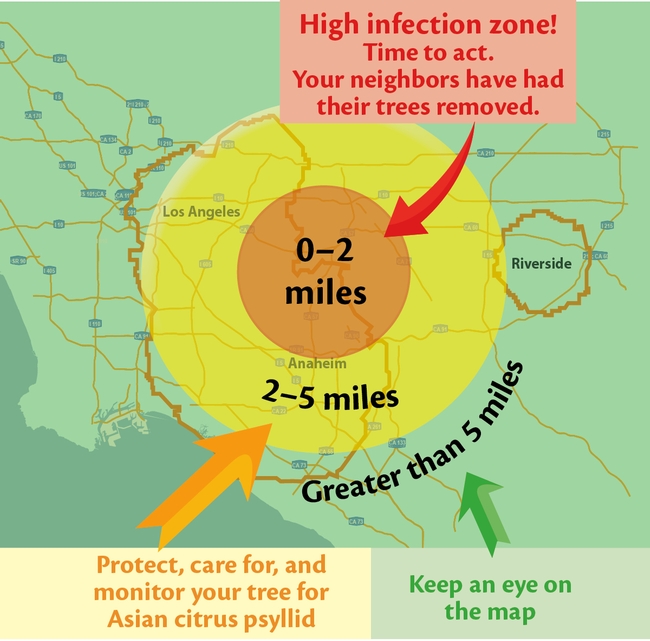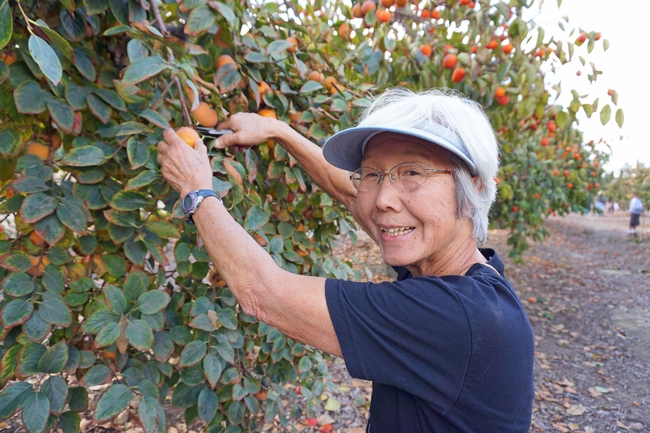Posts Tagged: citrus
Asian citrus psyllid study: Vigilance urged but ‘no cause for panic’
Preliminary results indicate 3.5% of ACP collected showed signs of bacterium that can cause huanglongbing
An ongoing study in the commercial citrus groves of coastal Southern California is looking at whether Asian citrus psyllids – the insect vector of huanglongbing “citrus greening” disease – are carrying the bacterium that can cause HLB.
Thus far, the project has tested more than 3,000 adult ACP collected from 15 commercial citrus sites across the region, of which 138 – just over 3.5% – had some level of the bacterium present, according to researchers from UC Agriculture and Natural Resources, UC Davis, UC Riverside and the University of Arizona, Tucson.
“While the results are a cause for concern, the situation in California is much better than in Florida and Texas, where ACP carrying the bacterium make up the majority of the population and HLB is widespread in commercial citrus,” said Neil McRoberts, a UC Davis plant pathologist and UC Integrated Pest Management program affiliate advisor. “The results indicate that there is no room for complacency, but also no cause for panic.”
Since the first HLB-infected tree in California was found in 2012, nearly 4,000 infected trees have been detected and removed from residential properties in Southern California, mainly in Orange and Los Angeles counties. According to McRoberts, “to date, no HLB has been found in commercial citrus” in California.
He stressed, however, that the aforementioned ACP study – funded by the HLB Multi Agency Coordination Group and managed by USDA-APHIS – does not involve any testing of trees for HLB and focuses only on looking at the insect which spreads the bacterium.
McRoberts also emphasized that the project's detections of the bacterium cannot be considered “official” because the researchers' lab procedures differ from the official testing protocols of the California Department of Food and Agriculture.
“Follow-up sampling by CDFA staff would allow official samples to be collected for further investigation, but is entirely voluntary for the growers involved,” he said, adding that his research team is currently wrapping up the sampling phase of the project, with data analysis continuing into 2023.
While commending the “huge coordinated effort” by the California citrus industry, California Department of Food and Agriculture, UC ANR and other partners to suppress the ACP vector and slow the spread of HLB, McRoberts also urged continued vigilance.
“Our study results indicate that it is not time to declare the emergency status for ACP/HLB in California over – the situation is still evolving,” he said.
For further information about the research, contact Neil McRoberts at nmcroberts@ucdavis.edu or (530) 752-3248.
You, too, can grow California’s oldest living orange variety
Sweet Mother Orange Tree released from quarantine
The 1000th tree okayed for growing by California's Citrus Clonal Protection Program happens to be the oldest living orange variety in the state.
The program, housed at UC Riverside, is the first of its kind in the world. It began in the 1950s, and its scientists spend up to three years testing and clearing citrus trees of disease so they can be released to commercial and private growers.
By law, every citrus tree newly propagated in California can be traced back to one mother tree created at UCR through the protection program. Program Director Georgios Vidalakis and his group begin their process by testing incoming trees for more than 30 citrus diseases, whether the diseases are known to have emerged in the state or not.
The treatment for any disease identified in that first round of testing is to make a new mini tree from a few cells of the original budwood — short, leafless twigs with buds meant for propagation. “We use special plant cells for this process that diseases cannot penetrate,” Vidalakis said.
After the mini tree grows large enough, program scientists go back and do a second round of testing for disease, making sure they picked the right cells for propagation and eliminating any prior trace of illness.
If it passes the arduous second set of tests, the new tree gets a variety index or VI number that accompanies it for the rest of its life, and it is released to the public.
Dubbed the Mother Orange Tree, Bidwell's Bar is a sweet Mediterranean orange brought to California from Mazatlán, Mexico, and planted in 1856. It was first planted near the Bidwell Bar Bridge near Oroville, then dug up and replanted twice.
Its survival skills are some of the reasons Tom Delfino, former California Citrus Nursery Society director, recommended the old orange tree for the protection program.
“Apparently this variety is very rugged,” Delfino said. “Not only has it survived a lot of cold Northern California winters, but the tree has been dug up and replanted twice — once to protect it from impending flood, and again to make way for the Oroville Dam.”
Much of the state's orange industry is based in areas with warm weather. Delfino, who lives in the San Francisco Bay Area, finds citrus an exciting challenge to grow. By suggesting Bidwell's Bar for approval, he was hoping the protection program would clear it so he could buy its budwood.
On the occasions he has visited the original tree, Delfino said the fruit in reaching distance was always gone. “I think it must be tasty because locals grab it for themselves,” he said. “Makes me even more eager to grow and eat my own. I'm extremely pleased the VI testing is completed so I can acquire it.”
Delfino also hopes that this variety will catch on with commercial growers.
“My thought is our citrus industry is concentrated in the southeastern San Joaquin Valley and is subject to a number of pests that like the warm climate there,” Delfino said. “Though this has seeds, which may be a deterrent, it can be grown in colder areas that discourage some of those insects.”
The tree arrived in California nearly two decades before the better-known Washington Navel orange grown by Eliza Tibbets in Riverside. The navel is named for a structure at the bottom end of the fruit, which resembles a belly button. This structure is actually a separate fruit inside the larger fruit. The Washington Navel is also seedless, contributing to its popularity.
“Bidwell's Bar is an example of what was grown in California before the Washington Navel came to dominate, and now that it has a VI number, others can grow it too,” said Tracy Kahn, curator of the Givaudan Citrus Variety Collection at UCR.
Kahn says it's important to preserve the genetic material from a tree with such significance to California. “Some people were worried it was going to die, but now we have an officially cleared source of this historic tree, and it is protected for future generations,” Kahn said.
Citrus threat target of $7 million multistate research project
UC ANR part of team led by Texas A&M AgriLife combating huanglongbing disease
Citrus greening, or huanglongbing disease (HLB), is the most devastating disease for orange and grapefruit trees in the U.S. Prevention and treatment methods have proven elusive, and a definitive cure does not exist.
Since HLB was detected in Florida in 2005, Florida's citrus production has fallen by 80%. Although there have been no HLB positive trees detected in commercial groves in California, more than 2,700 HLB positive trees have been detected on residential properties in the greater Los Angeles region.
“It is likely only a matter of time when the disease will spread to commercial fields, so our strategy in California is to try to eradicate the insect vector of the disease, Asian citrus psyllid,” said Greg Douhan, University of California Cooperative Extension citrus advisor for Tulare, Fresno and Madera counties.
Now, a public-private collaborative effort across Texas, California, Florida and Indiana will draw on prior successes in research and innovation to advance new, environmentally friendly and commercially viable control strategies for huanglongbing.
Led by scientists from Texas A&M AgriLife Research, the team includes three UC Agriculture and Natural Resources experts: Douhan; Sonia Rios, UCCE subtropical horticulture advisor for Riverside and San Diego counties; and Ben Faber, UCCE advisor for Ventura, Santa Barbara and San Luis Obispo counties.
$7 million USDA project
The $7 million, four-year AgriLife Research project is part of an $11 million suite of grants from the U.S. Department of Agriculture National Institute of Food and Agriculture, NIFA, to combat HLB. The coordinated agricultural project is also a NIFA Center of Excellence.
“Through multistate, interdisciplinary collaborations among universities, regulatory affairs consultants, state and federal agencies, and the citrus industry, we will pursue advanced testing and commercialization of promising therapies and extend outcomes to stakeholders,” said lead investigator Kranthi Mandadi, an AgriLife Research scientist at Weslaco and associate professor in the Department of Plant Pathology and Microbiology at the Texas A&M College of Agriculture and Life Sciences.
The UC ANR members of this collaboration will be responsible for sharing findings from the research with local citrus growers across Southern California, the desert region, the coastal region and the San Joaquin Valley.
“In addition to the ground-breaking research that will be taking place, this project will also help us continue to generate awareness and outreach and share the advancements taking place in the research that is currently being done to help protect California's citrus industry,” said Rios, the project's lead principal investigator in California.
Other institutions on the team include Texas A&M University-Kingsville Citrus Center, University of Florida, Southern Gardens Citrus, Purdue University and USDA Agricultural Research Service.
“This collaboration is an inspiring example of how research, industry, extension and outreach can create solutions that benefit everyone,” said Patrick J. Stover, vice chancellor of Texas A&M AgriLife, dean of the Texas A&M College of Agriculture and Life Sciences and director of Texas A&M AgriLife Research.
HLB solutions must overcome known challenges
An effective HLB treatment must avoid numerous pitfalls, Mandadi explained.
One major problem is getting a treatment to the infected inner parts of the tree. The disease-causing bacteria only infect a network of cells called the phloem, which distributes nutrients throughout a tree. Starved of nutrients, infected trees bear low-quality fruits and have shortened lifespans.
Treatments must reach the phloem to kill the bacteria. So, spraying treatments on leaves has little chance of success because citrus leaves' waxy coating usually prevents the treatments from penetrating.
Second, while the bacteria thrive in phloem, they do not grow in a petri dish. Until recently, scientists wishing to test treatments could only do so in living trees, in a slow and laborious process.
Third, orange and grapefruit trees are quite susceptible to the disease-causing bacteria and do not build immunity on their own. Strict quarantines are in place. Treatments must be tested in groves that are already infected.
Two types of potential HLB therapies will be tested using novel technologies
The teams will be working to advance two main types of treatment, employing technologies they've developed in the past to overcome the problems mentioned above.
First, a few years ago, Mandadi and his colleagues discovered a way to propagate the HLB-causing bacteria in the lab. This method involves growing the bacteria in tiny, root-like structures developed from infected trees. The team will use this so-called “hairy roots” method to screen treatments much faster than would be possible in citrus trees.
“Even though a particular peptide may have efficacy in the lab, we won't know if it will be expressed in sufficient levels in a tree and for enough time to kill the bacteria,” Mandadi said. “Viruses are smart, and sometimes they throw the peptide out. Field trials are crucial.”
The second type of treatment to undergo testing is synthetic or naturally occurring small molecules that may kill HLB-causing bacteria. Again, Mandadi's team will screen the molecules in hairy roots. A multistate team will further test the efficacy of the most promising molecules by injecting them into trunks of infected trees in the field.
A feasible HLB treatment is effective and profitable
Another hurdle to overcome is ensuring that growers and consumers accept the products the team develops.
“We have to convince producers that the use of therapies is profitable and consumers that the fruit from treated trees would be safe to eat,” Mandadi said.
Therefore, a multistate economics and marketing team will conduct studies to determine the extent of economic benefits to citrus growers. In addition, a multistate extension and outreach team will use diverse outlets to disseminate project information to stakeholders. This team will also survey growers to gauge how likely they are to try the treatments.
“The research team will be informed by those surveys,” Mandadi said. “We will also engage a project advisory board of representatives from academia, universities, state and federal agencies, industry, and growers. While we are doing the science, the advisory board will provide guidance on both the technical and practical aspects of the project.”
Project team members:
—Kranthi Mandadi, Texas A&M AgriLife Research.
—Mike Irey, Southern Gardens Citrus, Florida.
—Choaa El-Mohtar, University of Florida Institute of Food and Agricultural Sciences, Citrus Research and Education Center.
—Ray Yokomi, USDA-Agricultural Research Service, Parlier, California.
—Ute Albrecht, University of Florida IFAS Southwest Florida Research and Education Center.
—Veronica Ancona, Texas A&M University-Kingsville Citrus Center.
—Freddy Ibanez-Carrasco, Texas A&M AgriLife Research, Department of Entomology, Weslaco.
—Sonia Irigoyen, AgriLife Research, Texas A&M AgriLife Research and Extension Center at Weslaco.
—Ariel Singerman, University of Florida IFAS Citrus Research and Education Center.
—Jinha Jung, Purdue University, Indiana.
—Juan Enciso, Texas A&M AgriLife Research, Department of Biological and Agricultural Engineering, Weslaco.
—Samuel Zapata, Texas A&M AgriLife Extension, Department of Agricultural Economics, Weslaco.
—Olufemi Alabi, Texas A&M AgriLife Extension, Department of Plant Pathology and Microbiology, Weslaco.
—Sonia Rios, University of California Cooperative Extension, Riverside and San Diego counties.
—Ben Faber, University of California Cooperative Extension, Ventura, Santa Barbara and San Luis Obispo counties.
—Greg Douhan, University of California Cooperative Extension, Tulare, Fresno and Madera counties.
Preserving and eating citrus peels and watermelon rind
Growing up, my parents told us stories of how as kids, they kept from starving during the Great Depression by not letting anything edible go to waste. To stay alive, they learned to eat beef tripe (stomach lining), chicken feet, cow tongue and other things not normally consumed. It was their stories that got me interested in learning about and sharing information on parts of fruits and vegetables normally discarded that can be preserved and eaten. Examples include citrus peel and watermelon rind.
The next time you eat an orange, grapefruit, tangerine or other citrus, you don't need to throw out the peel. Instead you can dehydrate it. Remove the pith (the white fibrous material between the skin and the peel) before placing the peel in your food dehydrator. You can also dry your peels in other methods, such as in the oven. Visit the National Center for Home Food preservation (www.nchfp.uga.edu) for more information on these alternative methods. For more information on dehydrating orange peels, see https://anrcatalog.ucanr.edu/pdf/8199.pdf.
What do you do with the dehydrated citrus peel? You can use the dried peels to add flavor to teas, or boil them to infuse the flavor in soups or rice. You can also grind the dried peels into a powder and sprinkle it on yogurt, salads, baked goods and other edibles for added flavor.
Fresh citrus peels are also often candied. The process basically involves simmering the peels in either a sugary syrup or corn syrup. You can find recipes on how to candy citrus peel at http://cecentralsierra.ucanr.edu/files/226102.pdf, https://ucanr.edu/sites/mfp_of_cs/files/312473.pdf and other sites.
If you have a sweet tooth, remember citrus peel is a key ingredient in marmalades. You're not limited to just orange marmalade. With lemon and grapefruit peel in addition to orange peel, you can make a citrus marmalade. You can find the recipe at https://nchfp.uga.edu/how/can_07/citrus_marmalade.html.
When summer comes around and you partake of a refreshing watermelon, don't throw out the rind. You can make pickles from the watermelon rind. The process to pickle the watermelon rind is similar to pickling other fruit. You'll need canning salt, sugar, distilled white vinegar, cloves, cinnamon and lemon. You can find the recipe and instructions for making watermelon rind pickles at https://nchfp.uga.edu/how/can_06/watermelon_rind.html.
But if you're like me and don't care for pickled foods, fear not, you can use the watermelon rind to make watermelon rind preserves. Besides the rind, you'll need sugar, salt, lemon juice and ground ginger. You can find the recipe for making watermelon rind preserves at https://nchfp.uga.edu/how/can_07/watermelon_rind_preserves.html.
Or, take the watermelon rinds and candy them in a similar way that you candy citrus rinds. Peel the green off, cut them into chunks and cook them in a syrup until they're translucent and then dry them. You'll be surprised at how good they are. Find the recipe at https://ucanr.edu/sites/camasterfoodpreservers/files/335009.pdf.
So the next time you eat citrus or watermelon, don't throw out the peels and rind before trying candied citrus peels and dehydrating the peels, and making pickles, candy or preserves from the watermelon rind. Remember that old saying, “Waste not, want not!”
For more information about the UC Master Food Preserver Program, including the Food Preservation Video and Recipe Libraries, visit mfp.ucanr.edu.
Planting alternative backyard fruit trees in Southern California can help stop citrus threat
Southern California's mild Mediterranean climate makes it ideal for growing fruit trees in backyards, community gardens and school gardens. The trees provide wholesome fruit along with shade, beauty and enrichment for families and communities.
“With fresh fruit close at hand, it's easier to follow dietary guidelines that encourage filling half our plates with fruits and vegetables for good health,” said Rachel Surls, UC Cooperative Extension sustainable food systems advisor. “Besides, gardening is a great activity. Tending fruit trees teaches natural science, responsibility and appreciation for fresh food. And a garden gets people outside and engaged in physical activity.”
Citrus trees are favorites for Southern California backyards, but Surls and her team aim to get local gardeners thinking beyond lemons, limes, oranges and other citrus fruit. In the past several years, a deadly plant disease has been spreading among Southern California citrus, prompting quarantines and putting citrus orchards across the state at risk.
Surls and her team are working on an initiative with a corps of volunteer UC Master Gardeners in Los Angeles and surrounding counties to promote selection and planting of appropriate fruit trees. New brochures, a website, workshops and one-on-one consultations will guide Southern Californians in making tree decisions that are scientifically sound and community-focused.
The project addresses serious concerns about the rapid spread of huanglongbing (HLB) disease, also known as citrus greening. The insect that spreads HLB – the Asian citrus psyllid – was introduced into California in 2008. The disease made its first California appearance in a Los Angeles County backyard in 2012. HLB, which eventually kills every tree it infects, is now spreading rapidly in urban areas of Los Angeles and Orange counties, where quarantines have been put in place by the California Department of Food and Agriculture (CDFA).
“Citrus trees are so popular in Southern California. They are part of our history and regional identity,” Surls said. “Now we have the unfortunate responsibility of telling residents about this serious problem we are facing. In some cases, residents who live near infected trees should be proactive and remove their lemon, orange, mandarin and lime trees and replace them with different kinds of fruit.”
New web app shows residents' proximity to HLB disease
University of California Agriculture and Natural Resources IGIS programmers, in collaboration with UC Cooperative Extension, have created an HLB Monitoring Web App that allows residents to enter an address to determine how close they are to confirmed HLB outbreaks. If they are within 2 miles of a residence where an HLB-infected citrus tree was found, the app recommends replacement of citrus trees with non-citrus fruit trees, such as apples, peaches, avocados or persimmons.
Residents with citrus trees that are 2 to 5 miles from areas with HLB should keep a close eye on their trees, treat for Asian citrus psyllid and begin thinking about planting an alternative to citrus if the disease spreads to their area.
“Huanglongbing poses a serious threat to both backyard and commercial citrus in California if its spread is not halted,” Surls said. “By removing trees in areas where HLB has been found, residents are helping reduce its ability to spread, buying time for scientists to find a cure.”
CDFA is testing trees throughout the state and removing HLB-infected trees. However, the first visible symptoms of HLB – yellow mottled leaves – can appear months to years after infection. Even if they look perfectly healthy, citrus trees can be harboring the disease and allowing it to be spread by the tiny psyllid insect.
Current hotspots shown on the HLB Monitoring Web App include Rosemead, Montebello, Pico Rivera, San Gabriel, Hacienda Heights and Cerritos in Los Angeles County. In Orange County, HLB is spreading in communities around Garden Grove, Westminster and Santa Ana.
“We know removing citrus trees is going to be really hard for people,” Surls said. “But if you live within two miles of an infected tree, your tree is probably already infected, and HLB means your tree is going to die.”
To ease the transition, UC Master Gardeners are informing residents about alternatives that will produce fruit that's nutritious and delicious.
“So many types of fruit trees can be grown in Southern California,” Surls said. “Honestly, we have almost unlimited options. We live in a fruit tree grower's paradise. So we want to encourage local residents to think seriously about selecting non-citrus trees to replace their citrus.”
The information can also inform residents who are planning a new backyard orchard.
“They should consider some of the many wonderful fruit trees we can grow here — plant a pomegranate, plant a peach, plant a persimmon — but resist the temptation to plant more lemons, oranges and other citrus trees,” Surls said.
Making the decision to plant a certain type of tree should not be taken lightly.
“Planting a fruit tree is a big commitment. It will be part of your garden for years. Research the best options for your family and locations,” Surls said. “The UC Master Gardeners are here to help.”
Following are good options to consider for replacing citrus trees in Southern California, although recommendations may vary based on local climate:
Apples
Certain apple varieties that do not need to be exposed to cold temperatures grow and produce well in Southern California. Low-chill varieties include Anna, Beverly Hills, Dorset Golden, Fuji and Gala.
Figs
Figs grow well in full sun in Southern California. They can reach 10 to 30 feet tall, and are best for spacious areas.
Jujube
Jujubes are less common in Southern California, but are a valued fruit in Southeast Asian and will grow well under Southern California conditions. They grow about 15 feet tall. Jujubes are a good selection for inland valleys that get hot during the summer. The fruit tastes like small, crispy apples. Dried, they are similar to dates.
Loquat
A small- to medium-size tree that grows 10 to 20 feet high, loquats are easy to grow and have relatively few pests. Fresh, ripe loquats are sweet and aromatic. They can be used in jams, sauces and garnishes.
Persimmon
Persimmons ripen in autumn after the leaves have fallen, creating a beautiful landscape display. They are easy to grow in full sun and part shade. Persimmons can be eaten fresh or dried for a date-like fruit.
Pomegranate
Well-suited to Southern California's Mediterranean climate, pomegranates grow to about 15 feet in height. Pomegranates are pest- and disease-resistant. The fruit's seeds, coated with astringent juicy flesh, are called arils. Use arils to top salads or other dishes, or squeeze for juice or to make jelly.
Other fruit tree options for Southern California include mangos, guavas, pineapple guavas, peaches, nectarines and pears.
For more research-based information about alternative fruit trees, visit the UC Agriculture and Natural Resources website “California Backyard Orchard” at http://homeorchard.ucanr.edu.
Contact your local UC Master Gardener Program for additional advice:
Los Angeles County – http://celosangeles.ucanr.edu/UC_Master_Gardener_Program
Orange County – http://mgorange.ucanr.edu
Riverside County – https://ucanr.edu/sites/RiversideMG
San Bernardino County – http://mgsb.ucanr.edu
Ventura County – https://ucanr.edu/sites/VCMG
Funding for the ‘Alternatives to Citrus Fruit in the Fight against Huanglongbing Disease' project was made possible by the U.S. Department of Agriculture's (USDA) Agricultural Marketing Service through grant AM180100XXXXG003. Its contents are solely the responsibility of the authors and do not necessarily represent the official views of the USDA.


